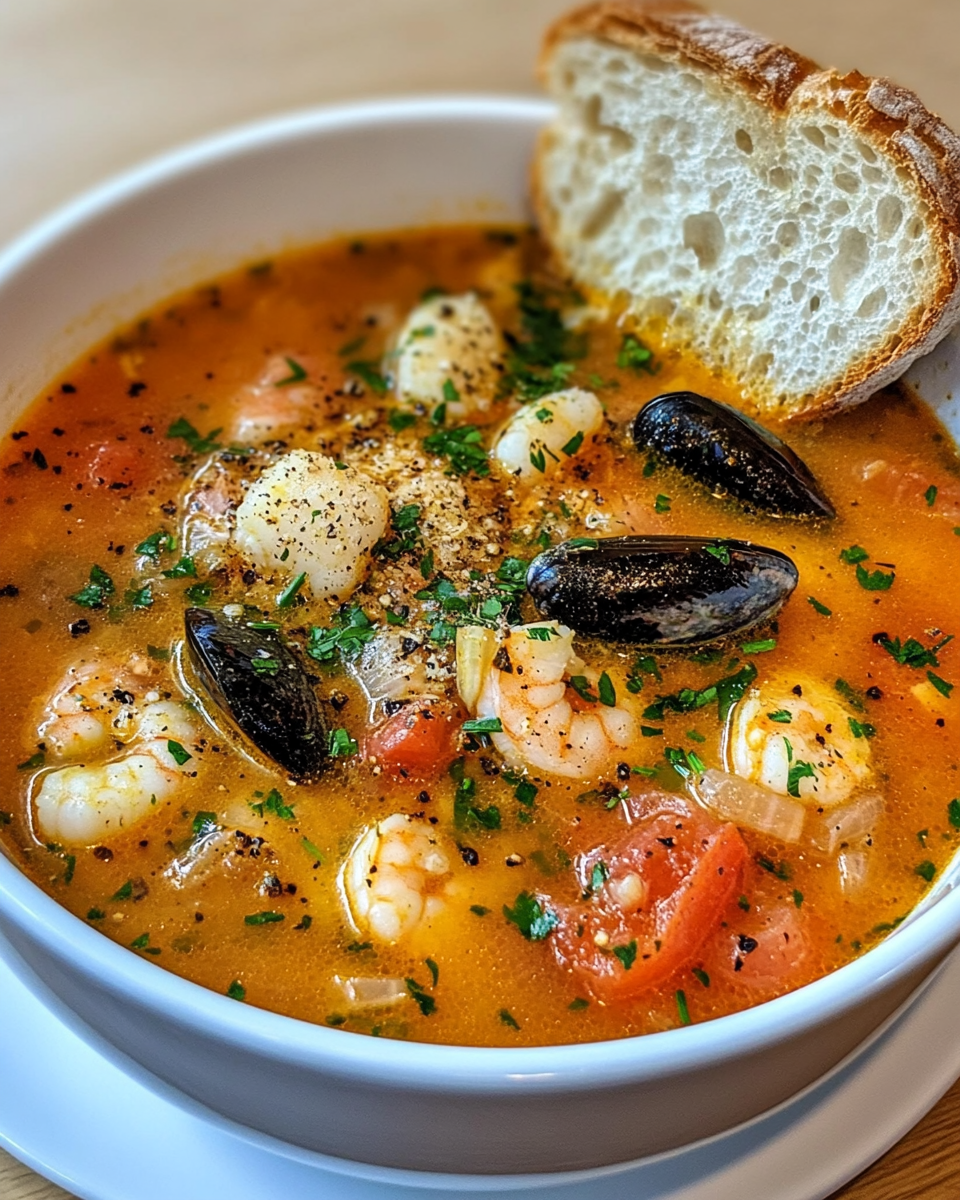The iconic Bouillabaisse hails from the sunny shores of Provence, originally crafted by fishermen who transformed their daily catch into a rich, flavorful stew. With its saffron-kissed broth, layers of aromatic vegetables, and a medley of fresh seafood, this dish is a celebration of Mediterranean simplicity and elegance. Perfect for cozy gatherings or a special date night in, this stew is both hearty and refined. Serve it with slices of toasted baguette and a drizzle of traditional rouille for the full French experience. Whether you’re new to French cuisine or a longtime admirer, Bouillabaisse is sure to become a treasured favorite.
Full Recipe:
Ingredients:
-
2 tablespoons olive oil
-
1 onion, finely chopped
-
2 leeks, white part only, sliced
-
3 garlic cloves, minced
-
1 large tomato, chopped
-
1 fennel bulb, thinly sliced
-
1 bay leaf
-
1/2 teaspoon saffron threads
-
1 teaspoon orange zest
-
1/2 teaspoon dried thyme
-
Salt and black pepper to taste
-
1/2 cup dry white wine
-
4 cups fish stock
-
1/2 pound firm white fish (like cod or halibut), cut into chunks
-
1/2 pound mussels, scrubbed and debearded
-
1/2 pound clams, scrubbed
-
1/2 pound shrimp, peeled and deveined
-
1/2 pound squid, cleaned and sliced into rings
-
Fresh parsley, chopped (for garnish)
-
Rustic baguette slices, toasted (for serving)
-
Optional: Rouille sauce for drizzling
Directions:
-
In a large pot or Dutch oven, heat the olive oil over medium heat.
-
Add the onion, leeks, and garlic. Sauté until soft and fragrant, about 5 minutes.
-
Stir in the chopped tomato, fennel, bay leaf, saffron, orange zest, thyme, salt, and pepper. Cook for another 5 minutes.
-
Pour in the white wine and fish stock. Bring to a boil, then reduce heat and simmer for 15 minutes.
-
Add the fish and simmer for 5 minutes.
-
Add the mussels, clams, shrimp, and squid. Cover and cook until shellfish open and shrimp are pink, about 5-7 minutes.
-
Discard any unopened shellfish. Taste and adjust seasoning.
-
Ladle stew into bowls, garnish with parsley, and serve with toasted baguette slices and optional rouille.
Prep Time: 15 minutes | Cooking Time: 30 minutes | Total Time: 45 minutes
Kcal: 370 kcal | Servings: 6 servings
The Story and Soul of Bouillabaisse: A Taste of Provence
Bouillabaisse isn’t just a seafood stew it’s a cultural icon, a symbol of Marseille’s vibrant coastal heritage, and a culinary experience that tells a story with every spoonful. With its roots firmly planted in the rocky shores of southern France, Bouillabaisse combines humble beginnings with gourmet flair, offering food lovers a dish rich in tradition, flavor, and meaning.
This article explores the origins, cultural significance, techniques, regional variations, and serving traditions of Bouillabaisse, concluding with why this storied recipe deserves a place in every kitchen from the curious home cook to the seasoned gourmand.
The Origins of Bouillabaisse: A Dish Born from Necessity
Bouillabaisse originated in the port city of Marseille, a bustling fishing town nestled along the Mediterranean coast. The word itself is derived from the Provençal Occitan language bolhir (to boil) and abaissar (to reduce the heat), which perfectly describes the cooking method: bring to a boil, then simmer.
Historically, this stew was not made from premium seafood. Instead, it was the meal of Provençal fishermen, who couldn’t sell the bony, tough, or less desirable fish they caught, such as rascasse (scorpionfish), conger eel, or gurnard. These would go into a pot with vegetables, herbs, and local olive oil, creating a rustic, warming stew that was both economical and nourishing.
Over time, Bouillabaisse gained popularity beyond the fishing community, slowly transforming from a fisherman’s lunch into a dish that appeared in elegant French bistros and home kitchens alike.
The Soul of Bouillabaisse: A Harmonious Marriage of Land and Sea
Bouillabaisse is so much more than “fish soup.” It’s a carefully balanced harmony of flavors sweet fennel, earthy leeks, garlic, tomatoes, saffron, herbs, and a mixture of fish and shellfish. The broth is the soul of the dish. It’s richly flavored with the sea, deepened by a base of aromatics, and kissed with saffron, which gives it that unmistakable golden hue.
The authentic version of Bouillabaisse typically includes three types of fish native to the Mediterranean, often including rascasse, sea robin, and conger. However, modern versions use a mix of locally available firm white fish (like cod or halibut), along with shellfish such as mussels, clams, shrimp, and sometimes squid or crab.
Bouillabaisse is traditionally served in two parts: the broth first, often ladled over toasted bread slathered with rouille (a garlicky, saffron-colored sauce), followed by the fish and shellfish arranged separately on a platter.
The Magic of Saffron and Aromatics
What sets Bouillabaisse apart from other seafood stews is its signature blend of herbs and spices, with saffron at the center. This prized spice gives the dish its warm color and exotic aroma. Saffron, while costly, is used sparingly and provides a subtle bitterness and floral undertone that complements the seafood.
The addition of orange zest adds brightness and a touch of sweetness, balancing the oceanic flavors. Other common herbs include thyme, bay leaf, and fennel fronds, each layering flavor and enhancing the stew’s depth.
The result is a broth that is rich yet delicate, fragrant yet clean, and deeply satisfying.
Bouillabaisse vs. Other Seafood Stews: What Makes It Unique?
There are many seafood stews around the world Italy’s cioppino, Spain’s zarzuela, Brazil’s moqueca, and the American clam chowder. Yet Bouillabaisse holds a unique place in this culinary canon.
What makes Bouillabaisse stand out?
-
Broth-forward preparation: Unlike many stews where seafood is simmered long in the pot, Bouillabaisse often features seafood cooked briefly and separately, preserving the texture and freshness.
-
Rouille accompaniment: This garlic, saffron, and chili pepper emulsion adds a zingy, creamy punch when spread on crusty bread and dipped in the broth.
-
Presentation and ritual: Bouillabaisse is more than a dish it’s an experience. Served in stages and savored slowly, it’s designed for lingering meals and meaningful moments.
-
Regional identity: While many stews are globally inspired, Bouillabaisse is tied to a specific locale, culture, and even sea othe Mediterranean.
Regional Variations and Modern Twists
Though Marseille lays claim to the most “authentic” Bouillabaisse, various towns along the Côte d’Azur have adapted the recipe to reflect local catches and traditions. Some versions add potatoes or carrots, while others intensify the broth with additional wine or even Pernod (an anise-flavored liqueur).
In modern kitchens, chefs might deconstruct Bouillabaisse into plated components, present it as a clear consommé, or create plant-based variations that honor the aromatic broth using vegetables and seaweed instead of seafood.
Even within home kitchens, many adaptations emerge depending on ingredient availability, dietary preferences, and culinary creativity.
Tips for Making Bouillabaisse at Home
Making Bouillabaisse at home is a rewarding challenge not difficult, but it requires care, patience, and quality ingredients.
Here are a few tips to get it right:
-
Use the freshest seafood you can find. This dish is all about celebrating the ocean’s bounty.
-
Don’t skip the saffron — a pinch goes a long way.
-
Make your own fish stock if possible. It forms the flavorful backbone of the dish.
-
Prepare a rouille — it’s worth the effort and adds authenticity.
-
Serve with a crusty French baguette to soak up every last drop.
Bouillabaisse may require a few extra steps compared to a typical stew, but the result is an elegant and deeply flavorful dish that’s worth every minute.
Pairing and Presentation
Bouillabaisse is ideally served with:
-
Crusty bread or baguette slices, preferably toasted with a rub of garlic
-
Rouille sauce, served on the side or smeared on the bread
-
A glass of dry white wine, like a Côtes de Provence, Picpoul de Pinet, or a crisp Sauvignon Blanc
-
A simple green salad with a lemon vinaigrette to balance the richness of the broth
When serving, ladle the broth into shallow bowls, arrange the seafood on top or serve separately, and garnish with fresh herbs like parsley or fennel fronds.
Cultural Importance and Festive Significance
In Marseille, Bouillabaisse is more than a meal it’s a celebration, often reserved for special occasions. It’s commonly enjoyed during family gatherings, holidays, and festive weekends along the coast.
Some restaurants even present Bouillabaisse as a multi-course event, starting with the broth, followed by the seafood, and finishing with cheese or dessert, making it an immersive culinary ritual.
In Provençal culture, Bouillabaisse represents a link between the land and the sea, a testament to sustainability (using the whole catch), and a symbol of community and tradition.
Conclusion:
Bouillabaisse is more than just a French seafood stew it’s a culinary masterpiece, a slice of history, and a sensory journey through southern France. With its robust broth, delicate seafood, and soul-soothing depth, it’s a dish that appeals to the heart as much as the palate.
Whether you’re recreating it for a romantic dinner, a family celebration, or simply exploring world cuisines from your kitchen, Bouillabaisse is a rewarding, satisfying, and impressive recipe to add to your repertoire.
By making Bouillabaisse, you’re not just preparing food you’re preserving a piece of Mediterranean culture, honoring generations of fishermen and chefs, and indulging in a timeless classic that continues to inspire and delight.






